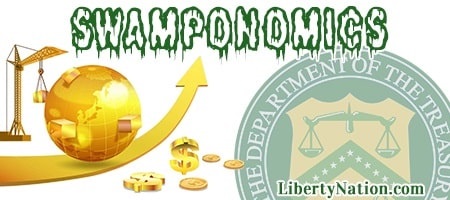Plus, the Fed is losing billions and consumer debt.
Despite campaigning against tariffs, President Joe Biden has kept his predecessor’s trade policies intact. During the 2020 campaign, Biden complained that then-President Donald Trump’s tariffs on China were “shortsighted,” arguing that they hurt US businesses and consumers. Years later, Biden has not only maintained these trade penalties on Beijing, but his administration has also doubled down on them. In fact, the White House has warned more tariffs could be arriving soon.
Biden Preps for More Tariffs
The White House is upset that China is flooding the international market with cheap green energy products like solar panels and electric vehicles. But if the chief objective is to make the world more environmentally friendly, why would the current regime in the US be unhappy? Anyway, Treasury Secretary Janet Yellen, who just visited our main competitor with the world’s second-largest economy, threatened additional tariffs on Beijing if it keeps bolstering its green energy exports.

Yellen told CNBC she wants a level playing field and would not rule out anything. The former Federal Reserve head noted that she would prefer to work with the Chinese government to carve out a solution. “I’m not thinking so much of export restrictions, as some shifts in their macroeconomic policy, and a reduction in the amount of, particularly local government subsidies, to firms,” Yellen said. “We just want to make sure that we’re not driven out of business and that our firms and workers have opportunities in these industries, which will be important ones in our future.”
In January, Axios reported that Biden aims to keep many of the 45th president’s tariffs on $300 billion in Chinese goods in place heading toward the November election. The news organization, citing three people close to the president’s re-election campaign, wants to avoid having Trump portray Biden as “soft,” so the real estate billionaire mogul’s tariffs will likely last for years to come, whatever this year’s electoral results.
This is unsurprising since Biden has emulated his 2024 opponent on many trade policies, like steel tariffs.
Federal Reserve Losing Billions
The Federal Reserve lost a record $114.3 billion in 2023, up from the previous year’s net loss of $58.8 billion. All that red ink has been driven by the US central bank’s inflation-fighting policies, particularly rising interest rates. With the benchmark federal funds rate unchanged at a 23-year high of a range between 5.25% and 5.5%, 2024 could be another year of hemorrhaging. According to research from the St. Louis Fed, it could take four years before the Federal Reserve recoups the income losses and sends profits to the Treasury Department.
 And, yes, Washington has received money from the Eccles Building, Between January 2011 and September 2022, the central bank handed the federal government approximately $1 trillion in cumulative remittances. Effectively, that was a fee to obtain a counterfeiting license. This was free money Republicans and Democrats could use to help partially plug the gaping budget hole. For the week ending April 3, data show that total Fed remittances to the Treasury are negative $161.3 billion.
And, yes, Washington has received money from the Eccles Building, Between January 2011 and September 2022, the central bank handed the federal government approximately $1 trillion in cumulative remittances. Effectively, that was a fee to obtain a counterfeiting license. This was free money Republicans and Democrats could use to help partially plug the gaping budget hole. For the week ending April 3, data show that total Fed remittances to the Treasury are negative $161.3 billion.
“Once the Fed returns to earning a positive net income, it will pay down the value of the deferred asset until it reaches zero, at which point the Fed will resume sending remittances to the Treasury,” St. Louis Fed economists wrote in a paper.
But taxpayers should not worry. The Federal Reserve cannot declare bankruptcy because it possesses the greatest device known to man: the printing press.
The Debt Delinquency Dilemma
US households are on the brink of financial disaster, although the current administration and mainstream media insist that all is well in the national economy. Consumers disagree. In fact, the results from the New York Fed’s March Survey of Consumer Expectations (SCE) suggest that many Americans are struggling in the present landscape and skeptical of what the smartest men and women in Washington are doing.
First, the one-year-ahead inflation expectations reading stood at 3% for the third consecutive month. This means the public doubts that the Eccles Building will achieve its 2% target rate by next year. Heck, the American people do not even believe the central bank will accomplish this feat in three years, as they estimate the annual inflation rate will be 2.9%, up from 2.7% in February.
Second, the median one-year-ahead point prediction for household income growth expectations was 3.1%. By comparison, the household spending growth one-year forecast was 5%. This represented quite the Bidenomics gap that would be hard to fill with anything other than more debt.
Finally, more households concede that they cannot service their debts. SCE findings show that the “mean probability of not being able to make minimum debt payments over the next three months” rose to 12.9%. When was it last this high? The pandemic-era lockdowns of May 2020. With $1.3 trillion in credit card debt and 22% interest rates, it is unsurprising that many consumers are barely keeping their heads above water under this president.
But Yellen claimed in the same CNBC interview that “we’ve got a good, strong economy” and “households are in very good financial shape.”

